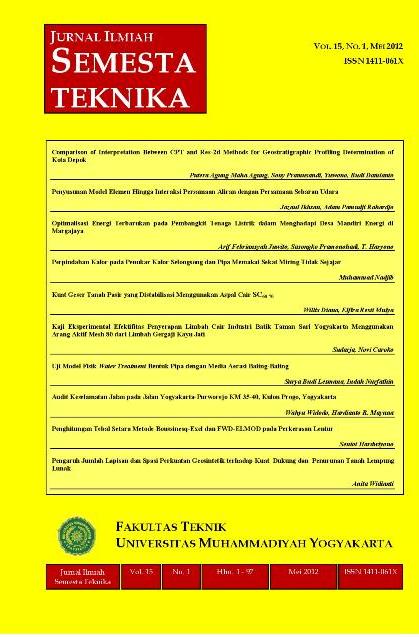Kuat Geser Tanah Pasir yang Distabilisasi Menggunakan Aspal Cair SC60-70
DOI:
https://doi.org/10.18196/st.v15i1.442Abstract
Soil is one of the most important parts in construction work. Soil being found in the field are vary in terms of its properties, and its quality usually does not meet the specified requirements for building construction on it including sandy soil. Sandy soil does not have cohesion value (c), so its shear strength is very low and can lead to collapse. Because of that, it needs to be stabilized to improve the parameter of soil shear strength which are friction angle value (φ) and cohesion value (c). Stabilizing material being used in this research is asphalt, in order to improve cohesion and soil density. Asphalt being used in this research is emulsified asphalt SC 60-70 which is Asphalt Cement (AC) dissolved in diesel oil. In this research, the shear-strength of sandy soil stabilized with emulsified asphalt SC 60-70 was analyzed by means of direct shear-strength testing. It can be concluded from the result that friction angle tends to increase with the increase of the asphalt content. It can also be shown that the lowest friction angle value was found being at 0% asphalt content, 35,753°, while the biggest friction angle value was found being at 5% asphalt content, 38,970° (increased 10,169%).
Downloads
Published
How to Cite
Issue
Section
License
Semesta Teknika is licensed under a Creative Commons Attribution 4.0 International License.
Authors who publish with this journal agree to the following terms:
- Authors retain copyright and grant the journal right of first publication with the work simultaneously licensed under a Creative Commons Attribution License that allows others to share the work with an acknowledgement of the work's authorship and initial publication in this journal.
- Authors are able to enter into separate, additional contractual arrangements for the non-exclusive distribution of the journal's published version of the work (e.g., post it to an institutional repository or publish it in a book), with an acknowledgement of its initial publication in this journal.
- Authors are permitted and encouraged to post their work online (e.g., in institutional repositories or on their website) prior to and during the submission process, as it can lead to productive exchanges, as well as earlier and greater citation of published work (See The Effect of Open Access).









